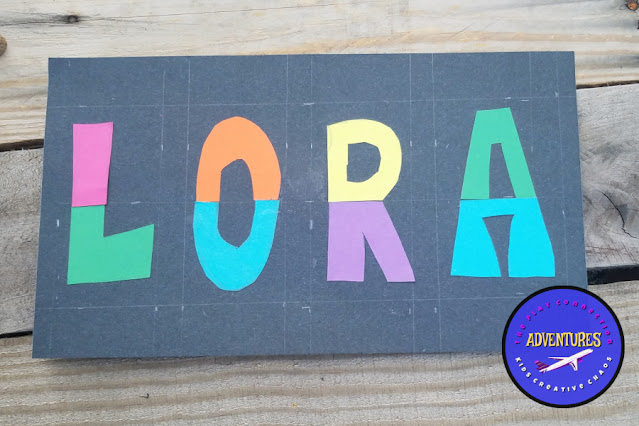COLOR THEORY COLOR SCHEME CUT PAPER LETTERS ART PROJECT
If you watch the popular NETFLIX series, Cobra Kai, you've probably noticed the t-shirts worn by the Anthony LaRusso character, played by Griffin Santopietro. In the series, Anthony is the son of Daniel and Amanda LaRusso, and the younger brother of Samantha LaRusso. He often wears cool printed tees, below the word LEGEND is printed in two tone letters across his shirt. The colorful block print letters inspired this letter color scheme art project perfect for a quick lesson on color theory.
This post contains Amazon and other affiliate links for your convenience.
Letter Art Project: Anthony LaRusso Legend Tee in Cobra Kai
In my high school art class, we've been working on several hand lettering projects with a letter theme. We started creating tag letters for a graffiti art project and then we moved on to a lesson color theory and how to blend with colored pencils from That Art Teacher. To review the basics of color theory or to achieve a better understanding of the color wheel, watch this video, Color Theory Basics or scroll down to read our simple definitions.
The video below is an awesome companion video to use when teaching the history of graffiti art.
LEGEND Color Theory Letter Project
This letter color scheme project can be be simple or more complicated and adapted for all grade levels. For a simple project for elementary students, simply cut and paste the letters onto a 6" x 12" white, gray, or black poster board using contrasting colors from the basic color wheel. For our homeschool friends that means: Red/Green, Blue/Orange, and Purple/Yellow. Remind your students to eyeball the letters and center the word on the page before the final glue down.
You might also like: How to Paint like Eric Carle
For high school students in a basic art class, remind the students that contrasting colors are simply colors that are opposite each other on the color wheel. This will give more color options. For more advanced classes, have art students design their letters based on a color scheme: monochromatic, complementary, double complementary, split complementary, triadic, tetradic, analagous, intermediate primary, secondary, or tertiary. We used cut, brightly colored paper in anticipation of a color paper unit on Matisse, but you can also use acrylic paints.
What are the Color Schemes?
Monochromatic - One color. A monochromatic color scheme ranges between lighter (tints) and darker (shades) versions of the base color or hue.
Primary - The basic colors. Red, Yellow, and Blue. With crayons, pencils, and paint, these colors can be combined to create the secondary colors. (Don't let Google and Digital Art confuse you.)
Secondary - Green, Orange, and Purple.
(Red + Blue) = Purple, (Red + Yellow) = Orange, (Yellow + Blue) = Green.
Triadic - Primary and secondary color schemes are also triadic colors schemes. A triadic color scheme is made up of three colors evenly spaced on the color wheel. These colors form a triangle across the color wheel.
Tertiary - A primary color + a secondary color. Tertiary colors combine primary and secondary colors to create compound colors: blue-green, blue-violet, red-orange, red-violet, yellow-orange, and yellow-green.
Complementary - Two colors that are on opposite sides of the color wheel. The basics are Red/Green, Blue/Orange, and Purple/Yellow. However, you can pull-out a color wheel to find more variations such as, Yellow-Orange/Blue Violet.
Double Complementary or Tetradic - Using two sets of Complementary colors together. For example, red/green paired with yellow/purple. A double complementary color scheme forms a rectangle across the color wheel.
Split Complementary - A split complementary scheme uses three colors. Start with one color, find its complement and then use the two colors on either side of it. If you look at the color wheel above, blue, violet (purple,) and yellow-orange form a split complementary triangle. Yellow-Orange/Blue-Violet being the contrasting colors and blue and violet are the splits. If using Blue-Violet, the split complementary colors are Orange and Yellow. Get it? Got it. Good!
Analogous - Analogous colors are next to each other on the color wheel. Only use three to five colors for this color scheme. Analogous schemes can use warm colors, cool colors, or a combination of both depending on where you start. For art that pops stick to three analogous colors.
Intermediate - The tertiary colors are every other color on the color wheel. Tertiary colors combine primary and secondary colors to create compound colors: blue-green, blue-violet, red-orange, red-violet, yellow-orange, and yellow-green. This is also known as an intermediate color scheme.
How to Make Block Color Scheme LEGEND Letters with Bright Colored Paper
Supplies:
Black, White, or Gray Poster Board (6" x 12")
Ruler
Pencil
Scissors or Xacto Knife
Brightly Colored Copy Paper or Construction Paper
Beginners will want to measure to choose letter size and then eyeball the position on the poster board before gluing it down. Divide 12" by the number of letters you choose to use. The answer will provide enough space for your letter and the space between each letter. For example, 12/6 = 2". Allow 1 1/2" for each letter and use the extra space to form a border and proper letter spacing.
More advanced students should use the ruler to lay out a grid on the poster board. Draw separate grid lines for the block letter, space between the letters, and a border around them. Showing the students how to layout and plan for the block letter spacing will prepare them for future work in sign painting, drafting, technical theatre, and architecture.
Draw a horizon line halfway down the middle of the paper at 3". This line serves as the dividing line for the color of the letters. Each letter will be two colors based on one of the color schemes listed above. for younger students, choose contrasting colors. Measure for at least a 1/4" border from the edges of the paper. The width of letters is determined by the number of letters used as mentioned above. If you cut the letters out from a block of paper, with an Xacto knife, you can use the paper as a template to paint letters for a future project.
Recommended:
















